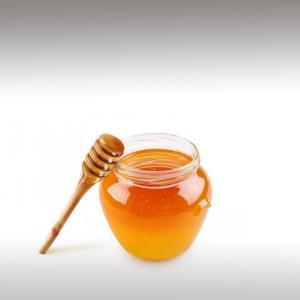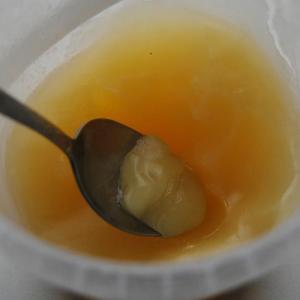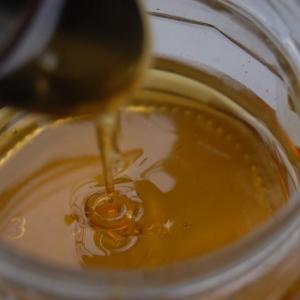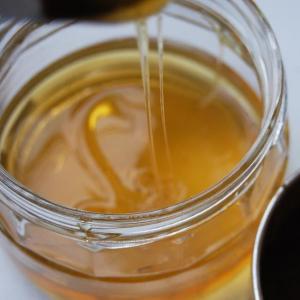
HONEY (MELLARIUS) - INGREDIENTS

BASE / GENERAL DATA
Information submited: February 18, 2015 Modified: May 30, 2018 By: OperaDreamhouse
Honey use and production has a long and varied history. In many cultures, honey has associations that go beyond its use as a food. Honey is frequently used as a talisman and symbol of sweetness. Honey collection is an ancient activity. Humans apparently began hunting for honey at least 8,000 years ago, as evidenced by a cave painting in Valencia, Spain. The painting is a Mesolithic rock painting, showing two honey-hunters collecting honey and honeycomb from a wild bee nest.
So far, the oldest remains of Honey have been found in the country of Georgia. Archaeologists have found honey remains on the inner surface of clay vessels unearthed an ancient tomb, dating back some 4,700–5,500 years.
In ancient Egypt, honey was used to sweeten cakes and biscuits, and was used in many other dishes. Ancient Egyptian and Middle Eastern peoples also used honey for embalming the dead. The fertility god of Egypt, Min, was offered honey.
Honey was also cultivated in ancient Mesoamerica. The Maya used Honey from the stingless bee for culinary purposes, and continue to do so today. The Maya also regard the bee as sacred.
Honey is a sweet food made by bees using nectar from flowers. The variety produced by honey bees (the genus Apis) is the one most commonly referred to, as it is the type of honey collected by most beekeepers and consumed by people. Honey bees convert nectar into Honey by a process of regurgitation and evaporation. They store it as a primary food source in wax honeycombs inside the beehive.
Honey gets its sweetness from the monosaccharides fructose and glucose, and has about the same relative sweetness as granulated sugar. It has attractive chemical properties for baking and a distinctive flavor that leads some people to prefer it over sugar and other sweeteners.
Honey's natural sugars are dehydrated, which prevents fermentation, with added enzymes to modify and transform their chemical composition and pH. Invertases and digestive acids hydrolyze sucrose to give the monosaccharides glucose and fructose. Honey bees transform saccharides into Honey by a process of regurgitation, a number of times, until it is partially digested. The bees do the regurgitation and digestion as a group.
Honey is produced by bees as a food source. To produce about 500 g of Honey, foraging Honey bees have to travel the equivalent of three times around the world. In cold weather or when fresh food sources are scarce, bees use their stored honey as their source of energy.
In the hive, the bees use their "Honey stomachs" to ingest and regurgitate the nectar a number of times until it is partially digested. Invertase synthesized by the bees and digestive acids hydrolyze sucrose to give the same mixture of glucose and fructose. The bees work together as a group with the regurgitation and digestion until the product reaches a desired quality. It is then stored in honeycomb cells. After the final regurgitation, the honeycomb is left unsealed.
The melting point of crystallized Honey is between 40 and 50 °C , depending on its composition. The rate of crystallization is affected by many factors, but the primary factor is the ratio of the main sugars: fructose to glucose. Honeys that are supersaturated with a very high percentage of glucose, such as brassica Honey, will crystallize almost immediately after harvesting, while Honeys with a low percentage of glucose, such as chestnut or tupelo honey, do not crystallize.
Raw Honey is Honey as it exists in the beehive or as obtained by extraction, settling or straining, without adding heat (although some Honey that has been "minimally processed" is often labeled as Raw Honey). Raw Honey contains some pollen and may contain small particles of Wax. Some allergy sufferers wrongly believe that raw, local Honey can help build tolerance to the Pollen in the air.
High-quality Honey can be distinguished by fragrance, taste, and consistency. Ripe, freshly collected, high-quality honey at 20 °C should flow from a knife in a straight stream, without breaking into separate drops. After falling down, the honey should form a bead.
In jars, fresh Honey should appear as a pure, consistent fluid, and should not set in layers. Within a few weeks to a few months of extraction, many varieties of Honey crystallize into a cream-colored solid. Some varieties of Honey, including Tupelo, Acacia, and Sage, crystallize less regularly.
Chemical structure:
The average pH of Honey is 3,9, but can range from 3,4 to 6,1. Honey contains many kinds of acids, both organic and amino. Honey can contain up to 18 of the 20 amino acids. However, amino acid content is almost negligible in Honey, accounting for only 0,05–0,1% of the composition. The main amino acid is proline. Amino acids are derived almost solely from the bodies of the bees.
Gluconic acidis formed by the actions of an enzyme called glucose oxidase. Other organic acids are minor, consisting of formic, acetic, butyric, citric, lactic, malic, pyroglutamic, propionic, valeric, capronic, palmitic, and succinic, among many others.
Typical honey analysis:
Fructose - 38.2%
So far, the oldest remains of Honey have been found in the country of Georgia. Archaeologists have found honey remains on the inner surface of clay vessels unearthed an ancient tomb, dating back some 4,700–5,500 years.
In ancient Egypt, honey was used to sweeten cakes and biscuits, and was used in many other dishes. Ancient Egyptian and Middle Eastern peoples also used honey for embalming the dead. The fertility god of Egypt, Min, was offered honey.
Honey was also cultivated in ancient Mesoamerica. The Maya used Honey from the stingless bee for culinary purposes, and continue to do so today. The Maya also regard the bee as sacred.
Honey is a sweet food made by bees using nectar from flowers. The variety produced by honey bees (the genus Apis) is the one most commonly referred to, as it is the type of honey collected by most beekeepers and consumed by people. Honey bees convert nectar into Honey by a process of regurgitation and evaporation. They store it as a primary food source in wax honeycombs inside the beehive.
Honey gets its sweetness from the monosaccharides fructose and glucose, and has about the same relative sweetness as granulated sugar. It has attractive chemical properties for baking and a distinctive flavor that leads some people to prefer it over sugar and other sweeteners.
Honey's natural sugars are dehydrated, which prevents fermentation, with added enzymes to modify and transform their chemical composition and pH. Invertases and digestive acids hydrolyze sucrose to give the monosaccharides glucose and fructose. Honey bees transform saccharides into Honey by a process of regurgitation, a number of times, until it is partially digested. The bees do the regurgitation and digestion as a group.
Honey is produced by bees as a food source. To produce about 500 g of Honey, foraging Honey bees have to travel the equivalent of three times around the world. In cold weather or when fresh food sources are scarce, bees use their stored honey as their source of energy.
In the hive, the bees use their "Honey stomachs" to ingest and regurgitate the nectar a number of times until it is partially digested. Invertase synthesized by the bees and digestive acids hydrolyze sucrose to give the same mixture of glucose and fructose. The bees work together as a group with the regurgitation and digestion until the product reaches a desired quality. It is then stored in honeycomb cells. After the final regurgitation, the honeycomb is left unsealed.
The melting point of crystallized Honey is between 40 and 50 °C , depending on its composition. The rate of crystallization is affected by many factors, but the primary factor is the ratio of the main sugars: fructose to glucose. Honeys that are supersaturated with a very high percentage of glucose, such as brassica Honey, will crystallize almost immediately after harvesting, while Honeys with a low percentage of glucose, such as chestnut or tupelo honey, do not crystallize.
Raw Honey is Honey as it exists in the beehive or as obtained by extraction, settling or straining, without adding heat (although some Honey that has been "minimally processed" is often labeled as Raw Honey). Raw Honey contains some pollen and may contain small particles of Wax. Some allergy sufferers wrongly believe that raw, local Honey can help build tolerance to the Pollen in the air.
High-quality Honey can be distinguished by fragrance, taste, and consistency. Ripe, freshly collected, high-quality honey at 20 °C should flow from a knife in a straight stream, without breaking into separate drops. After falling down, the honey should form a bead.
In jars, fresh Honey should appear as a pure, consistent fluid, and should not set in layers. Within a few weeks to a few months of extraction, many varieties of Honey crystallize into a cream-colored solid. Some varieties of Honey, including Tupelo, Acacia, and Sage, crystallize less regularly.
Chemical structure:
The average pH of Honey is 3,9, but can range from 3,4 to 6,1. Honey contains many kinds of acids, both organic and amino. Honey can contain up to 18 of the 20 amino acids. However, amino acid content is almost negligible in Honey, accounting for only 0,05–0,1% of the composition. The main amino acid is proline. Amino acids are derived almost solely from the bodies of the bees.
Gluconic acidis formed by the actions of an enzyme called glucose oxidase. Other organic acids are minor, consisting of formic, acetic, butyric, citric, lactic, malic, pyroglutamic, propionic, valeric, capronic, palmitic, and succinic, among many others.
Typical honey analysis:
Fructose - 38.2%
Glucose - 31.3%
Maltose - 7.1%
Sucrose - 1.3%
Water - 17.2%
Higher sugars - 1.5%
Ash - 0.2%
Other/undetermined - 3.2%
Because of its unique composition and chemical properties, Honey is suitable for long-term storage, and is easily assimilated even after long preservation. Honey, and objects immersed in Honey, have been preserved for decades and even centuries. Regardless of preservation, Honey may crystallize over time. The crystals can be dissolved by heating the Honey.
Maltose - 7.1%
Sucrose - 1.3%
Water - 17.2%
Higher sugars - 1.5%
Ash - 0.2%
Other/undetermined - 3.2%
Because of its unique composition and chemical properties, Honey is suitable for long-term storage, and is easily assimilated even after long preservation. Honey, and objects immersed in Honey, have been preserved for decades and even centuries. Regardless of preservation, Honey may crystallize over time. The crystals can be dissolved by heating the Honey.

SPIRITUAL PRACTISES DATA

MEDICINE / HEALTH DATA

BEAUTY / COSMETICS DATA

FOOD / COOKING DATA
COMMENTS
No comments.
Newest mixtures containing Honey (Mellarius):

Cucumber and honey healthy drink
September 19, 2015

Refreshing mask for eyes
September 16, 2015

Coconut matcha latte
June 22, 2015

Immune system booster (suitable for II - type of diabetes)
June 17, 2015

Daily metabolism-boosting immune drink
May 19, 2015

Home made Golden milk
May 12, 2015

Immune system booster
April 20, 2015

Raw white chocolate with coconut cream
February 18, 2015





